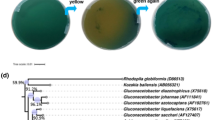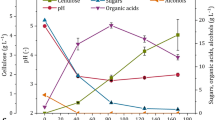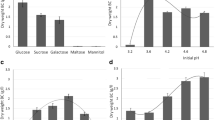Abstract
In order to reduce of the manufacturing cost of bacterial cellulose (BC), BC production by Acetobacter sp. V6 was investigated in shaking culture using molasses and corn steep liquor (CSL) as the sole carbon and nitrogen sources, respectively. The highest BC production was obtained with Ca3(PO4)2-treated molasses. Maximum BC yield (2.21 ± 0.04 g/l) was obtained at 5% (w/v) total sugar in molasses. In improved medium containing molasses and CSL, BC production was observed in the medium after 1 day of incubation and increased rapidly thereafter with maximum yield (3.12 ± 0.03 g/l) at 8 days. This value was approximately twofold higher than the yield in the complex medium. Physical properties of BC from the complex and molasses media were studied using Fourier-transform infrared (FT-IR) spectroscopy and X-ray diffractometer. By FT-IR, all the BC were found to be of cellulose type І, the same as typical native cellulose. The relative crystallinity of BC produced in the complex and molasses media were 83.02 and 67.27%, respectively. These results suggest that molasses and CSL can be useful low-cost substrates for BC production by Acetobacter sp. V6 without supplementation with expensive nitrogen complexes such as yeast extract and polypeptone, leading to the reduction in the production costs.






Similar content being viewed by others
References
Ross, P., Mayer, R., & Benziman, M. (1991). Microbiological Review, 55, 35–58.
Iguchi, M., Yamanaka, S., & Budhiono, A. (2000). Journal of Materials Science, 35, 261–270.
Okiyama, A., Shirae, H., Kano, H., & Yamanaka, S. (1992). Food Hydrocolloids, 6, 471–477.
Coucheron, D. H. (1991). Journal of Bacteriology, 173, 5723–5731.
Rias, B., Moldes, A. B., Dominguez, J. M., & Parajo, J. C. (2004). International Journal of Food Microbiology, 97, 93–98.
Chao, Y., Sugano, Y., & Shoda, M. (2001). Applied Microbiology and Biotechnology, 55, 673–679.
Oikawa, T., Ohtori, T., & Ameyama, M. (1995). Bioscience, Biotechnology, and Biochemistry, 59, 331–332.
Son, H. J., Kim, H. G., Kim, K. K., Kim, H. S., Kim, Y. G., & Lee, S. J. (2003). Bioresource Technology, 86, 215–219.
Roukas, T. (1996). Journal of Food Engineering, 27, 87–96.
Calabia, B. P., & Tokiwa, Y. (2007). Biotechnology Letters, 29, 1329–1332.
Pazouki, M., Felse, P. A., Sinha, J., & Panda, T. (2000). Bioprocess Engineering, 22, 353–361.
Solaiman, D. K. Y., Ashby, R. D., Zerkowski, J. A., & Foglia, T. A. (2007). Biotechnology Letters, 29, 1341–1347.
Kona, R. P., Qureshi, N., & Pai, J. S. (2001). Bioresource Technology, 78, 123–126.
Son, H. J., Lee, O. M., Kim, Y. G., & Lee, S. J. (2000). Korean Journal of Applied Microbiology and Biotechnology, 28, 134–138.
Heo, M. S., & Son, H. J. (2002). Biotechnology and Applied Biochemistry, 36, 41–45.
Valla, S., & Kjosbakken, J. (1982). Journal of General Microbiology, 128, 1401–1408.
Roukas, T., & Kotzekidou, P. (1997). Enzyme and Microbial Technology, 21, 273–276.
Schramm, M., & Hestrin, S. (1954). Journal of General Microbiology, 11, 123–129.
Segal, L., Creely, J., Martin, A., & Conrad, C. (1959). Textile Research Journal, 29, 786–794.
Chaplin, M. F., & Kennedy, J. F. (1986). Carbohydrate analysis: a practical approach. Washington DC: IRL.
Schramm, M., Gromet, Z., & Hestrin, S. (1957). Nature, 179, 28–29.
Bae, S., & Shoda, M. (2004). Biotechnology Progress, 20, 1366–1371.
Bae, S., & Shoda, M. (2005). Applied Microbiology and Biotechnology, 67, 45–51.
Lazaridou, A., Roukas, T., Biliaderis, C. G., & Vaikousi, H. (2002). Enzyme and Microbial Technology, 31, 122–132.
Noro, N., Sugano, Y., & Shoda, M. (2004). Applied Microbiology and Biotechnology, 64, 199–205.
Marechal, Y., & Chanzy, H. (2000). Journal of Molecular Structure, 523, 183–196.
Oh, S. Y., Yoo, D. I., Shin, Y., & Kim, H. C. (2005). Carbohydrate Research, 340, 2376–2391.
Sturcova, A., His, I., Apperley, D. C., Sugiyama, J., & Jarvis, M. C. (2004). Biomacromolecules, 5, 1333–1339.
Sugiyama, J., Persson, J., & Chanzy, H. (1991). Macromolecules, 24, 2461–2466.
Nelson, M. L., & O'Connor, R. T. (1964). Journal of Applied Polymer Science, 8, 1311–1324.
Jung, R., Kim, Y., & Jin, H. J. (2007). Textile Science and Engineering, 44, 130–133.
Uhlin, K. I., Atalla, R. H., & Thompson, N. S. (1995). Cellulose, 2, 129–144.
Keshk, S., & Sameshima, K. (2006). Applied Microbiology and Biotechnology, 72, 291–296.
Watanabe, K., Tabuchi, M., Morinaga, Y., & Yoshinaga, F. (1998). Cellulose, 5, 187–200.
Iwata, T., Indrarti, L., & Azuma, J. (1998). Cellulose, 5, 215–228.
Yamamoto, H., Horii, F., & Hirai, A. (1996). Cellulose, 3, 229–242.
Acknowledgment
This work was supported by 2008 Joint Research Center of PNU-Fraunhofer IGB Grant of Pusan National University.
Author information
Authors and Affiliations
Corresponding author
Rights and permissions
About this article
Cite this article
Jung, HI., Lee, OM., Jeong, JH. et al. Production and Characterization of Cellulose by Acetobacter sp. V6 Using a Cost-Effective Molasses–Corn Steep Liquor Medium. Appl Biochem Biotechnol 162, 486–497 (2010). https://doi.org/10.1007/s12010-009-8759-9
Received:
Accepted:
Published:
Issue Date:
DOI: https://doi.org/10.1007/s12010-009-8759-9




